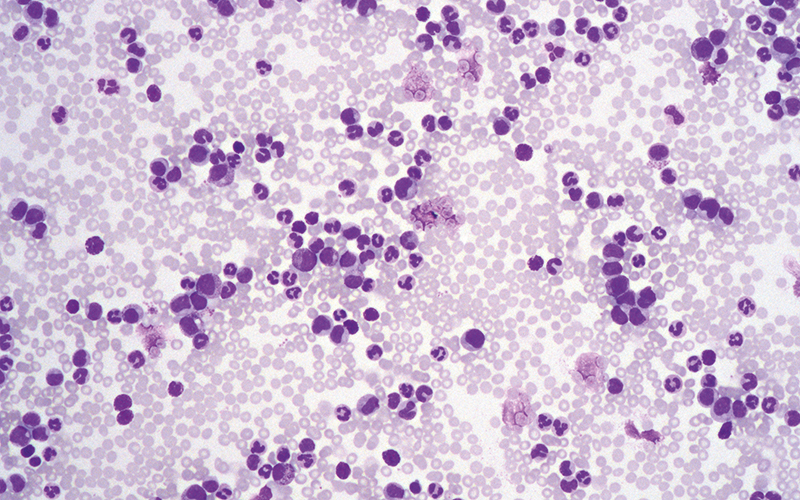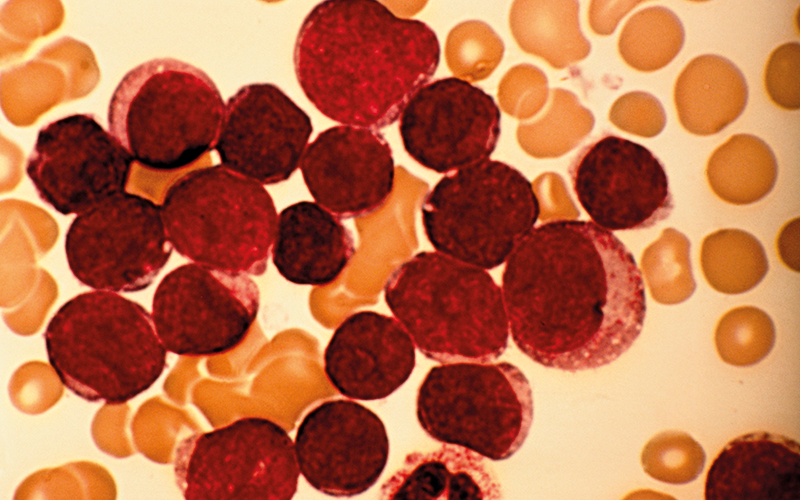Deputy Editor Dr Mark Hajjawi summarises some articles recently published in the British Journal of Biomedical Science.

The British Journal of Biomedical Science is one of the leading international scientific journals. This synopsis will summarise some of the original research articles published over the last quarter and look forward to the new special editions that have just launched and are accepting submissions.
RNA splicing and leukaemia treatment

Submitted as part of the special edition on “Advances in Cancer Diagnosis and Treatment”, Wodi et al. presented a potential novel treatment strategy for acute myeloid leukaemia. RNA splicing occurs when a precursor messenger RNA (pre-mRNA) is transformed into the mature messenger RNA (mRNA). In this process the introns (non-coding regions) are removed and the exons (coding regions) pieced back together. Alternative splicing, in which one multi-exon gene can produce many different mRNA transcripts, via skipping or retaining introns and exons, is a widespread process that accounts for some of the complexity of the proteome. Dysregulated alternative splicing is a feature of many cancers. It is within this complex process that Wodi and colleagues presented evidence for a novel therapeutic treatment.
Splice factors regulate alternative splicing; SR proteins are an important family of splice factors. SRSF1 is a well-studied member of the SR protein family know to be linked to cancer. The activity of SRSF1 is in turn regulated by splice factor protein kinases, and SRPK1 in particular. Wodi and colleagues used a 3-(trifluoromethyl)anilide scaffold named SPHINX to inhibit the activity of the splice factor protein kinase in a cell culture model of leukaemia, thereby manipulating alternative splicing.
SPHINX was shown to directly reduce splice factor protein kinase activity, and therefore reduce SR protein phosphorylation. SPHINX reduced the viability of the Kasumi-1 leukaemic cell model used and increased apoptosis. Next the authors combined SPHINX with the chemotherapy drugs azacitidine or imatinib. They found that the anti-cancer apoptotic effects of these drugs and SPHINX were amplified when used together.
The authors have demonstrated the potential power of this novel therapeutic model in the Kasumi-1 model of acute myeloblastic leukaemia. However, their success was less clear in the K562 cell line model of chronic myelogenous leukaemia, where SPHINX had less impact. The authors, through this well-designed study, have presented evidence that targeting splice factor kinases is a promising future treatment for some cancers, but warn that these factors have the potential to act as both oncogene or tumour suppressor, depending on the context.
Mitochondrial epigenetics and diabetes mellitus
It is widely accepted that genetics and lifestyle are key factors in the development and progression of type 2 diabetes mellitus (T2DM). Recently, it has become clear that epigenetics also plays a key role in T2DM. Epigenetics is the study of the transient or permanent changes that alter gene expression, without altering the DNA sequence. The three main methods of epigenetic regulation of gene expression are: DNA methylation, histone post-translational modification, and non-coding RNA.
Low et al. reviewed the impact that DNA methylation plays in T2DM. Methylation of nuclear DNA involves the addition of a methyl group (CH3) from S-adenosyl methionine to the fifth carbon of the cytosine residues, leading to the formation of 5-methylcytosine and the by-product S-adenosylhomocysteine. This process is catalysed by a family of enzymes known as the DNA methyltransferases. The addition of this methyl group typically inhibits gene expression. Mitochondrial DNA (mtDNA), which is separate and distinct from nuclear DNA (nDNA), is also under the regulation of methylation. Mitochondrial-localised DNA methyltransferases have been identified, supporting this claim. Histone post-translational modification and non-coding RNA have also been reported to play a role in mtDNA epigenetics. However, it is unclear if the non-coding RNA epigenetic control processes in the mitochondria share a common link with the epigenetic control of nDNA.
Low and colleagues reviewed the role of mtDNA methylation in T2DM in people, mice and cell culture experiments. They found evidence to suggest that there is a link between hypermethylation of mtDNA, insulin resistance and retinopathy. This highlights that understanding the mitochondrial epigenetic profile is required before we can fully elucidate, and control, the pathogenesis of T2DM.
The authors conclude their review with a stark warning that epigenetic regulation of mtDNA is a controversial field, prone to mistakes and pitfalls. Technological limitations, from the isolation of mitochondria, the differentiation of mtDNA from nDNA, through to the identification of methylation of DNA itself, all make this an extremely challenging and complex field.
Single nucleotide polymorphisms and COVID-19
Ghazy et al. studied the effect of genetic variation on the outcomes of people with COVID-19. Their study involved 240 people divided into three groups: 80 patients with severe COVID-19 infection, 80 with a mild COVID-19 infection, and 80 people in an age- and sex-matched non-infected control group. Severity of COVID-19 was judged by evidence of pneumonia on a lung CT, O2 saturation, respiratory rate, level of consciousness as determined by the Glasgow Coma Scale, and clinical symptoms. The authors’ aim was to assess the influence of single nucleotide polymorphisms in genes linked to the immune systems on the outcomes of COVID-19.
The human leukocyte antigens (HLA) are an important part of the immune system. They are specialised molecules on the surface of cells that present antigenic peptides to T-cells. For any viral infection of a cell, viral antigen presentation on the cell’s surface and induction of cellular immunity occurs mainly through the HLA system.
“Interferons limit virus spread between cells, preventing viral replication”

Interferon-lambda-4 (IFNλ4), a member of the type III interferons family, controls the expression of the antiviral IFN-stimulated gene-5 (ISG-5). ISG-5 in turn controls the antiviral response of IFN-α. Interferons play an essential role in limiting virus spread between cells, preventing viral replication, and promoting phagocytosis. Therefore, HLA and IFNλ4 genetic variations could have an impact on the immune response to SARS-CoV-2 and, in turn, the outcome for people with COVID-19.
Ghazy and colleagues presented evidence to show that HLA-DQ rs7453920AG+AA, HLA-DPrs3077GA+GG, and IFNλ4 rs73555604CT+CC genotypes are independent risk factors for a more severe manifestation of COVID-19. Their analysis showed that these alleles were more common in people with severe disease compared with the mild and control groups. Additionally, the coexistence of each of these risk factors in a single person increases their susceptibility to severe disease by several fold. The structure of their study also confirmed, as previously reported, that being male, older and non-vaccinated are significant risk factors for severe disease.
The authors suggest that a person’s risk of developing a severe form of COVID-19 could be calculated by using an analysis of their genetic profile and the single nucleotide polymorphisms present, along with other risk factors. However, they highlight that their study was conducted in an Egyptian population and it is not known if HLA and IFNλ4 are risk factors in other ethnic groups. Studies elsewhere found that DRB1*04:01 significantly affects the severity of COVID-19 and it is more frequent among a North Western European population. The work of Ghazy et al. provides clear evidence that genetic polymorphisms influence the outcomes of COVID-19.
These articles can be freely downloaded from frontierspartnerships.org/journals/british-journal-of-biomedical-science.
- Wodi C, Belali T, Morse R, Porazinski S and Ladomery M (2023) SPHINX-Based Combination Therapy as a Potential Novel Treatment Strategy for Acute Myeloid Leukaemia. Br J Biomed Sci 80:11041. doi: 10.3389/bjbs.2023.11041
- Low HC, Chilian WM, Ratnam W, Karupaiah T, Md Noh MF, Mansor F, Ng ZX and Pung YF (2023) Changes in Mitochondrial Epigenome in Type 2 Diabetes Mellitus. Br J Biomed Sci 80:10884. doi: 10.3389/bjbs.2023.10884
- Ghazy AA, Alrasheedi AN, Elashri M, Moussa HH, Rashwan EK, Amer I, El Sharawy S, Elgamal S, Tawfik S, Abdelnasser M and Elsheredy A (2023) Relevance of HLA-DP/DQ and INF-λ4 Polymorphisms to COVID-19 Outcomes. Br J Biomed Sci 80:11044. doi: 10.3389/bjbs.2023.11044
Special Editions

Since the last update provided by Deputy Editor Dr Guy Edward Orchard, the British Journal of Biomedical Science has launched three more special editions, all of which are currently accepting submissions.
Technological Advancements in Biomedical Science
This special issue, edited by Ian Paterson, Mark Hajjawi, Guy Edward Orchard, Victoria Bradley and Shing Cheng Tan, focuses on research papers and reviews on technological advancements in biomedical science. This is a wide field, focusing on the latest methodologies, but in all cases it would be expected that the novel approach be validated on clinical samples in the laboratory, and the scientific rationale underpinning any new technology to be fully explained.
Diagnostic Microbiology

The special edition on Diagnostic Microbiology, edited by Brigid Lucey and James O’Connor, invites manuscripts from scientists working in the field of diagnostic microbiology. This may be either a review of current methods and algorithms for the diagnosis of infectious diseases or a research paper. Functional or mechanistic studies reporting on the role of the laboratory in both the management of infectious diseases and the epidemiology of infections are welcomed.
Current Reviews in the Biomedical Sciences
This special issue will publish high-quality scholarly review papers on key topics in the biomedical sciences. Edited by Sheri Scott, Mark Hajjawi, Guy Edward Orchard and Ian Paterson, it aims to highlight recent advances in the field, whilst emphasising important directions and new possibilities for future inquiries. We anticipate this will promote discussion in the biomedical science community that will translate to best practice applications in clinical, and health policy settings.
Education and Training in Biomedical Science

Biomedical science is a rapidly expanding discipline in relation to technological advances, scientific research and healthcare delivery. As such it is fundamentally important that education providers deliver educational and training programmes that embed and promote the development of the essential skills required when seeking employment in such varied sectors so that graduates are workforce-ready. Edited by Sheri Scott, Beverley Cherie Millar, and Stephen McClean, this special edition will showcase the best practices in pedagogical approaches which have significantly impacted teaching, workplace training and assessment in the biomedical sciences.
IBMS members can publish for free in the Journal and any of the special editions. After the peer-review process, manuscripts that are accepted will be freely available forever via the open-access system.
Image credit | Science-Photo-library | Shutterstock | iStock



